November 7, 2013 weblog
Neck tattoo patent filing from Motorola targets improved sound

(Phys.org) —Motorola's vision of wearables extends beyond watches and spectacles into new consumer territory that would involve people wearing tattoos on their skin as supportive communication tools with their devices to improve sound. In this instance, according to a patent filing, Motorola is thinking in terms of a tattoo that is worn on the person's throat.
The patent is titled Coupling an Electronic Skin Tattoo to a Mobile Communication Device, first filed in May last year. The skin-born device is described in the patent filing as "A system for providing auxiliary voice input to a mobile communication device (MCD), comprising: an electronic skin tattoo capable of being applied to a throat region of a body; the electronic skin tattoo further comprising: a microphone embedded in the electronic skin tattoo; a transceiver that enables wireless communication with the mobile communication device; a power supply configured to receive energizing signals from a personal area network associated with the MCD; a controller communicatively coupled to the power supply; and wherein the electronic skin tattoo is capable of receiving an initialization signal at the controller and from the MCD to initiate reception of an audio stream picked up from the throat region of the body for subsequent audio detection by the MCD under an improved signal-to-noise ratio than without employing the electronic skin tattoo."
The skin tattoo could communicate with a phone or other device by Bluetooth, NFC or other wireless protocols.
"Mobile communication devices are often operated in noisy environments. For example, large stadiums, busy streets, restaurants, and emergency situations can be extremely loud and include varying frequencies of acoustic noise," said the patent filers,."Communication can reasonably be improved and even enhanced with a method and system for reducing the acoustic noise in such environments and environments and contexts"
.
What about a power supply for the tattoo? Motorola said a power supply can be configured to receive signals from external sources, including a personal area network employing NFC, Bluetooth.RTM, or Zigbee.RTM technology. The power supply can also simply be a battery that may or may not be rechargeable.
Earlier this year, Motorola's senior vice president of advance research, Regina Dugan, showed an electronic tattoo at the D11 conference in California. The tattoos at the time were from a Massachusetts-based firm MC10 and made from silicon and electronic circuits that bend with the wearer's body.
More information: via Engadget
© 2013 Phys.org




















